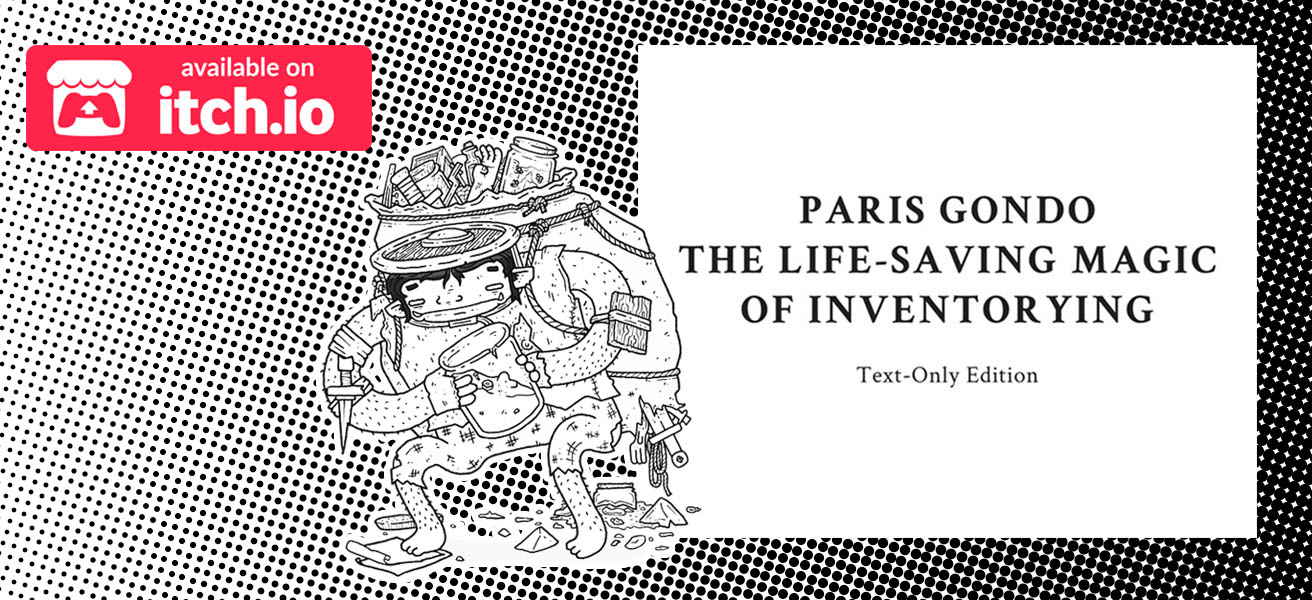Review of ARC: Doom Tabletop RPG

I read this work in a good 2-3 hours, although it is about 170 pages. Similar to Mausritter, which was presented last time, I had the feeling that I could take something with me for all kinds of other game sessions and game systems. It is these works that show me that indie authors can develop beautiful approaches that might get lost in the design of big games under the case of “we’ve always done it this way”.
ARC is a rules-light but atmospheric role-playing game. The core of ARC is a doom that can take place on a personal level or plunge the entire world into the abyss. Players take on the roles of heroes that stand against this doom and want to prevent it. The question is whether they are up to the task or the world changes because of their failure.
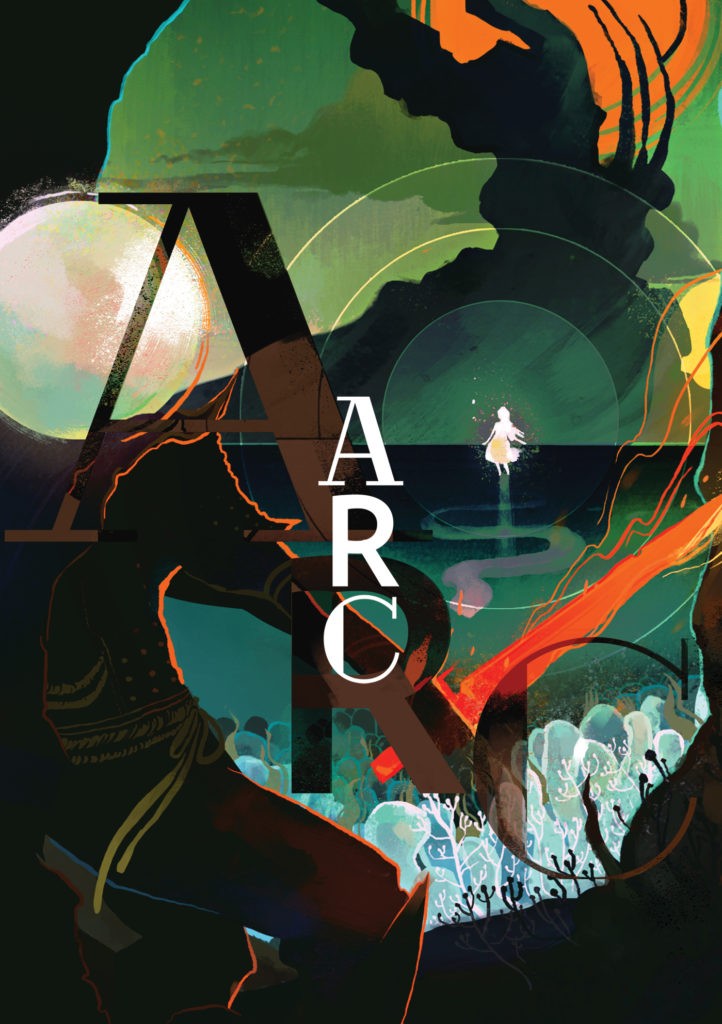
- Publisher: Exalted Funeral
- Release Date: 2021
- Language: English
- Pages: ca. 170
- Format: PDF / Print
- Price: 10 $ (Financial Hardship) / 20 $ for the PDF / 30 $ for Softcover + PDF / 50 $ for Hardcover + PDF on Kickstarter (as of this writing the Preorder Store is closed)
The end is nigh!
ARC’s selling points are: A threat that the heroes face, easy rules and Doomsday Clocks. Regardless of whether the heroes are actively opposing the threat or having a coffee break, those doomsday clocks take place in real time and allow the doom to advance, . The exciting thing is that these doomsday clocks tick depending on the length of the campaign. The shorter the campaign, the faster the clocks tick. Conversely, this means that the ARC campaign is timed in advance by the group.
For this, the game defines the Doom, the Omens and Moments. While the doom is the great evil, the event that must be prevented (the plot of the story, so to speak), the omens are subplots. They are milestones of the quest one would say in Ironsworn, because when the omens have been resolved, it slows down the doomsday clocks. Once all the omens have been vanquished, the threat is dealt with.
The Heroes
But first of all, we need heroes to face this end. For this, you can quickly roll out some random descriptions to give you a picture of your character, e.g. “You’re a rebellious lion who feuded with all four winds and is an amateur poet.” Then the mechanical part of character creation begins. In six steps we determine:
- Determine Approach Scores
- Assign Blood & Guts Modifiers
- Assign Skill Ranks
- Determine Inventory
- Answer Character-Building Questions
- Determine Bonds
Characters also receive experience points in real time and can use them to improve approach bonuses, become better at skills and increase modifiers of blood and guts.
Approach Scores
In ARC, checks are made with a d6. The aim is to roll below a threshold number. This value is determined by the Approach and a Skill. There are three different approaches in ARC: Creative, Careful and Concentrated.
For character creation, the values 0, +1 and +2 are now distributed among the three approaches.
Blood & Guts
Blood & Guts represent the condition of the character. While blood is the physical condition and can be equated with hit protection in other games, guts is the mental condition and thus mental health. The physical and mental health varies from day to day. After a long rest, which is 5 minutes of real time, 2d6 are rolled for both guts and blood and the respective modifier is added. The point about real time is important here because some actions in ARC are in game time and real time. You can also decide not to re-roll the dice during a rest. Then only a small amount of blood and guts is regenerated. During character creation, a total of 6 points are allocated to guts and blood. These then result in the modifier for these two character values.
If the blood or guts value is used up, the points of the approaches are reduced with each damage. If they fall to 0, the hero falls. As soon as a hero falls, the person playing can decide whether the hero dies or lives. If they live on, this has a consequence such as the hero no longer being able to communicate verbally or visually, but learning telepathy.
Skills & Checks
The threshold number for a check results overall from the approach and the skill that is applied. Disarming a trap, for example, could be tried careful with tinkering. If the careful approach has a +2 bonus and tinkering +1, then the limit is three.
You now throw a d6. If the value thrown is below the threshold number, it is a Success. If the result is above it, it is a Fail. A special case is when the result of the dice is equal to the threshold number. Then the person playing can decide whether it is a Success with Consequence or a Fail with Opportunity. If you have a rank in a skill and roll a 1 on a test, you may roll a d6 again. If this also shows a 1, then it is a flawless success or a Success with Opportunity. You can also sacrifice 3 blood and 3 guts to turn a tie in a check into a success, or turn a failed check into a failure with opportunity or a success with consequence. But what skills are there in ARC?

In ARC there are the broad areas of Knowledge Skills, Social Skills, Physical Skills, Pragmatic Skills, Prowess. Thus, skills such as: Academic, Culture, Observation, Charisma, Guile, Impress, Acrobatics, Coordination, Weaponry, Trade, Survival, Tinkering, Arcane, Focusing and many more.
When creating a character, two of the 18 skills can now be assigned a +2 bonus each, as well as three with a +1 bonus. As with the approaches, the maximum bonus of skills is +3.
Items, Techniques & Spells
Each character has 30 points to acquire items. Items are categorised as Damage and Defence, Supplies and Sundries, Oddities and Valuables, Spells and Techniques. Items in the Damage and Defence categories increase the defence or damage against or from physical or mental attacks, depending on the value of the item. It is funny that besides the studded leather armour, something like critical thinking and devastating vocabulary can also be found here. The other items from Supplies and Sundries or Oddities and Valuables are items that do not bring any values with them, but are purely for the narrative or items that become relevant for the plot. These categories include items such as the blood of a divine being, a telepathic yak, a complete encyclopaedia and many more.
However, this is different for spells and techniques. These can be selected several times and then also allow more frequent use. After a long rest and possibly a specific ritual, which is unique, the charges are restored. In ARC, spells can also be cast in the normal way and as an enhanced version. For the latter, a skill check has to be made. If this is successful, the enhanced version is cast. Otherwise, the spell or technique is blocked for 15 minutes in real time. In any case, one use is consumed. Learning new spells and techniques requires 1-4 checks, depending on their complexity, which may only be rolled every 15 minutes in real time.
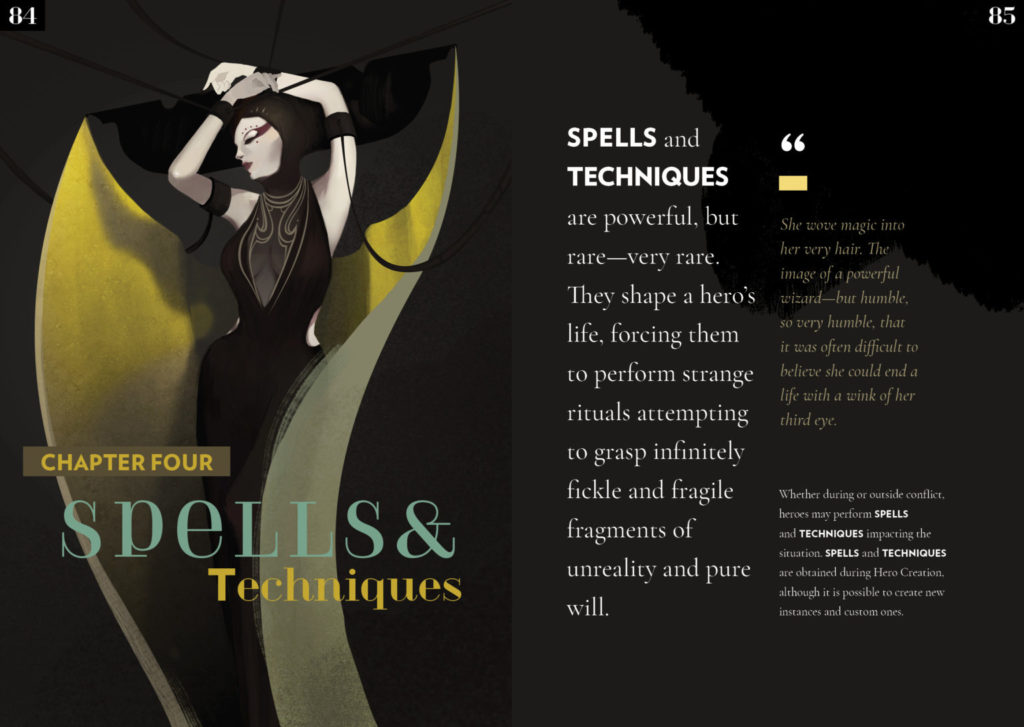
Some of the techniques and spells are very powerful. The target’s memory can be manipulated, secret doors can be conjured that not only lead to a random new location, but in the enhanced version also to an omen or the Doomsday Clock can be suspended or even time travel into the past.
Answer Character-Building Questions
ARC provides three personality and backstory questions for the players to answer for their characters and share with the group:
- What makes them different from others?
- There are three rumors about them. What are they and who believes it?
- What was the most painful lesson your hero had to learn?
Determine Bonds
As in Dungeon World, bonds are formed between the characters of the hero group. These bonds are represented by squares and have two levels: Minor Level and Major Level. Minor level fill one quadrant of a square. A major level is a filled square. The bonds indicate what bonus to a check a character with whom you have a bond gets when you help that character.

However, how do you get bonds with characters? When you create a character, you choose one character with whom you have six minor bonds and one character with whom you have three minor bonds. After that, you get a minor bond when you accept an inconvenience to help a character. This can be taking on someone’s debt or burden, providing a useful resource to an ally, or defending the other in a conflict. However, you only get this bond for such acts in the first square.
For the second square you have to accept harm to help an ally or expose yourself to serious risk. For this, you also get bonds in the second square and also two small bonds for each deed instead.
If you make a permanently life-changing, greatly difficult personal decision or a likely fatal sacrifice for others, you get four minor bonds. These can also fill the third square.
Mechanically, however, bonds mean the following: For each square that is completely filled, the character you have a bond with gets +1 to a check if you assist on that skill test. Alternatively, you can “burn” a small bond to allow a re-roll on a check.
Questions about the bonds with other persons
However, one should also explain the bonds and thus provide a background for the story and not just function as a mechanical component. Questions that could be asked about the bonds:
- You greatly admire the other.
- The other hero intrigues you.
- You become reminded of someone else from their past.
- You know them from before.
- The other makes you feel like you want to protect them.
- There are feelings involved or you know something else about the other.
- …
The Doomsday Clock & Omens
Now we get to the core of the game. The heroes try to stop the omens and thus prevent the doom. The doom can take various forms. Examples mentioned in the rulebook are:
- The escape of a hungry demon lord who wants to consume an entire kingdom.
- The wedding of the local chieftain.
- Children’s laughter is being stolen by a miserable trickster god.
Omens for the doom “The escape of a hungry demon lord who wants to consume an entire kingdom.” could read:
- The local cult is hoarding gold and gems for a secret ritual.
- Royal defences are sparse and uncoordinated, because the Council of Lords has disbanded.
- The Grey Magus has disappeared, leaving only a mysterious map.
Depending on the length of the campaign, the Doomsday Clock will run faster or slower. For a session of 3-4 hours, it is suggested that a moment is consumed every 30 minutes in real time. A session ARC has moments equal to 3 x number of hours of play. When a moment is consumed, the GM rolls a d6 for each omen not stopped. If a 5-6 is rolled, another moment is consumed.
For campaigns of 2-3 sessions, it is recommended that 1.5 moments per hour perish and the number of moments is equal to 1.5 x number of hours played. For campaigns of four or more sessions, 1.5 moments per session should perish and the total number of moments should be 1.5 x number of sessions.
What happens next?
The goal of the heroes is to prevent the doom, but what happens if this was successful or not?
ARC suggests several possibilities for the end. When the demise has been prevented:
- Bask in Success.
- Face ever grander dooms.
If the doom was not prevented:
- Accept your fate and describe an epilogue of the characters and world after the apocalypse.
- The apocalypse changes the world but does not destroy it. In the ruins of the old world, your new journey begins. What does this journey look like?
- You stand against fate and rebel. You are given a second chance and rewind.
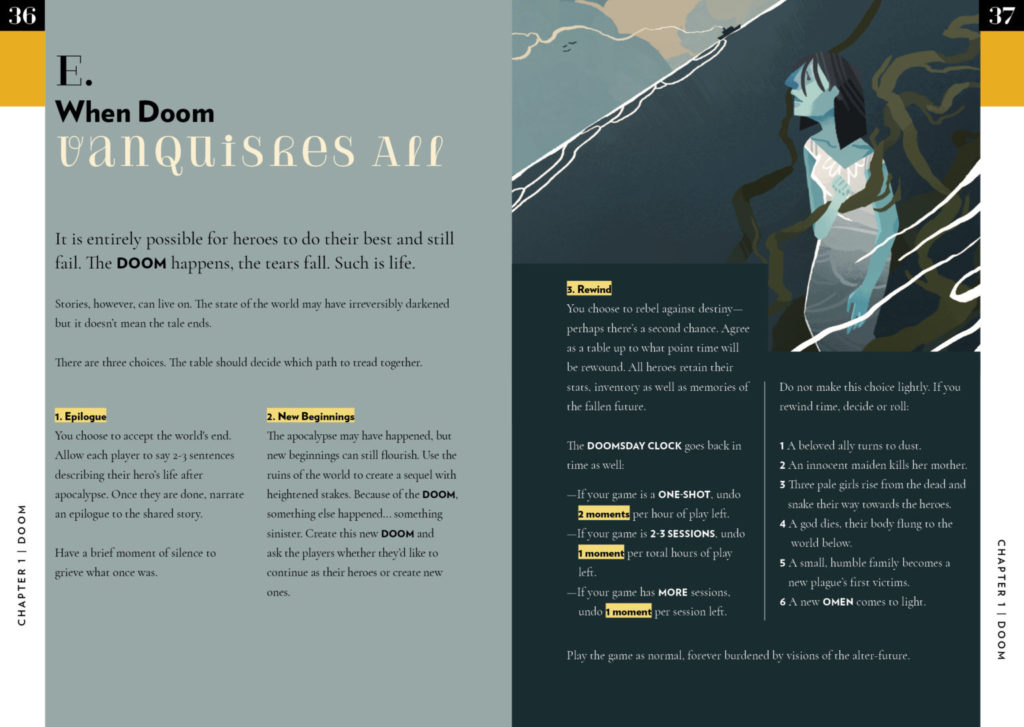
A few things happen, if you choose rewind. The doomsday clock turns back. It depends on the remaining length of the campaign how many moments are restored. The group decides at which moment they jump back. The heroes keep their stats, items and memories of the doom and the future. But there is a price to pay. On a d6 table, you can roll or decide the cost to be met. Among them are points like: A beloved ally turns to dust or a new omen arises.
The Presentation
ARC’s rulebook is a work of art. Layout elements are recurring, but text that should be highlighted is highlighted in yellow, in bold, has a larger font in the middle of the text. Background colour of pages is white, grey-blue, dark green-blue and many more. The whole book is very lively and colourful. Graphics are usefully integrated for explanations and illustrations but also quotations or in-game texts nicely underline the fairytale character of the rulebook and show what stories ARC makes possible.
But what if I don’t like fantasy?
The author points out in ARC that spells and techniques are not exhaustive lists and can be expanded. But although ARC is a fantasy game in thought, the author writes that for a cyberpunk story, for example, “only” skills, spells and techniques need to be adapted to the new setting. The core of the game, however, does not need to be adapted.
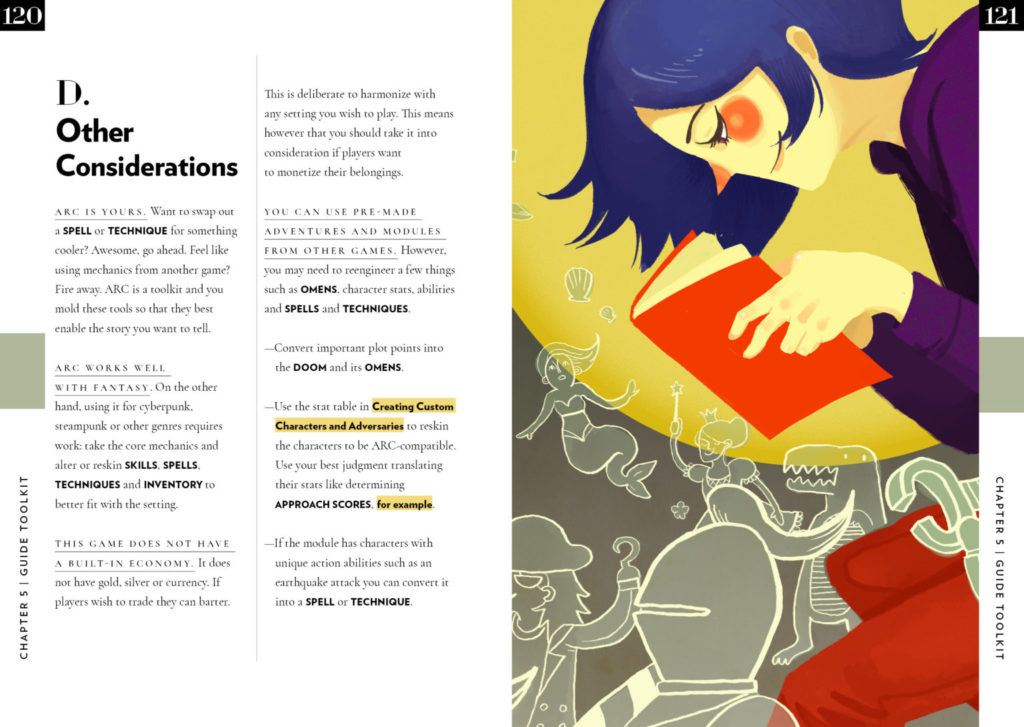
Conclusion
I looked at the Kickstarter Quickstarter and found the idea of the doomsday clocks exciting. Although I’m still unsure how well the whole thing will work in the real game. Still, the game reads excitingly and because of the layout it is fun to read. It doesn’t get dull or boring and also reads smoothly. The rules are supposed to be easy and don’t seem overly complicated or complex. The omens are sort of fronts from Dungeon World or queststarters from Ironsworn and provide short sentences as a starting point for subplots, which is a good help for the otherwise quite open game and also reminiscent of narrative games in design. If the PDF stays at its €10 even after the Kickstarter, you certainly can’t go wrong with this game.
But ARC has some cool ideas, like the enhanced spells and techniques, the clocks and real time, and the doom and omens for the campaign. Here, too, the wheel is not completely reinvented, because in some other games you may have seen one or the other component. In my eyes, it is once again exciting how these building blocks are put together in ARC and result in an artful and fairytale-like game. Even if it turns out that the real-time doomsday clocks are more of a hindrance than a really cool mechanic, you can cannibalise ARC for one or two interesting ideas or have a rulebook with a beautiful layout.



